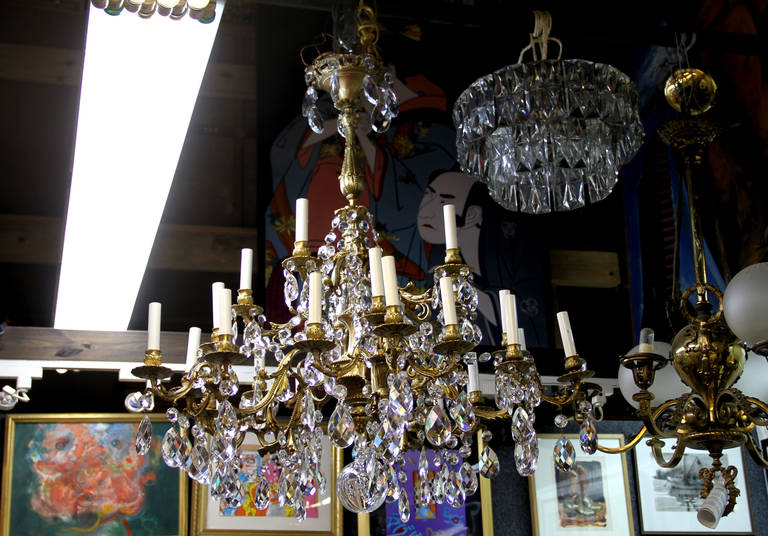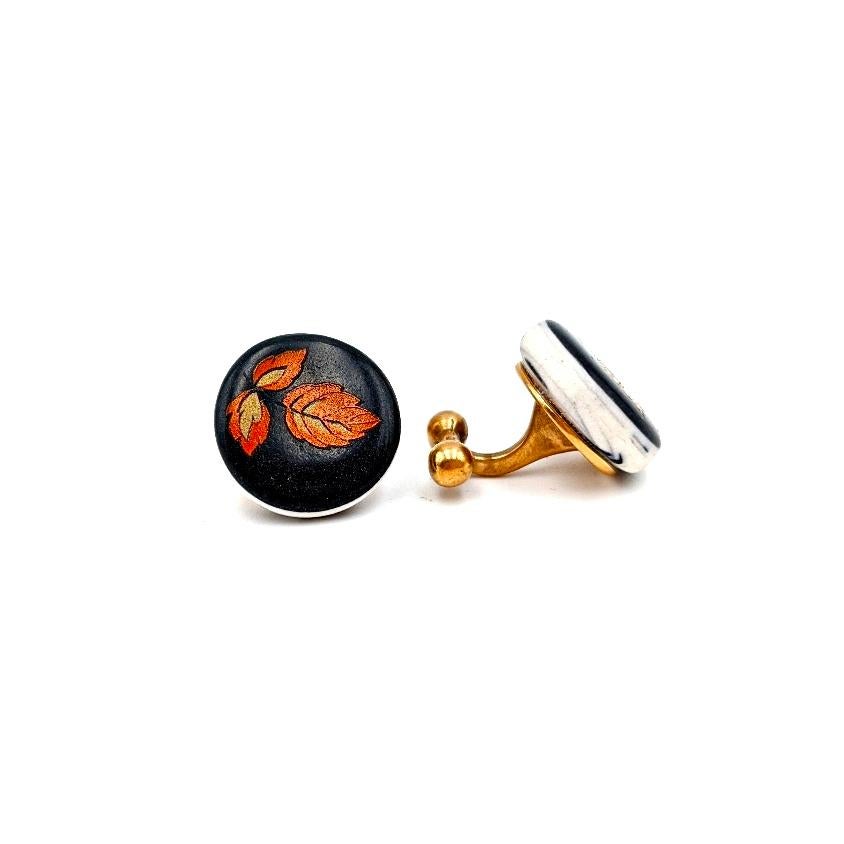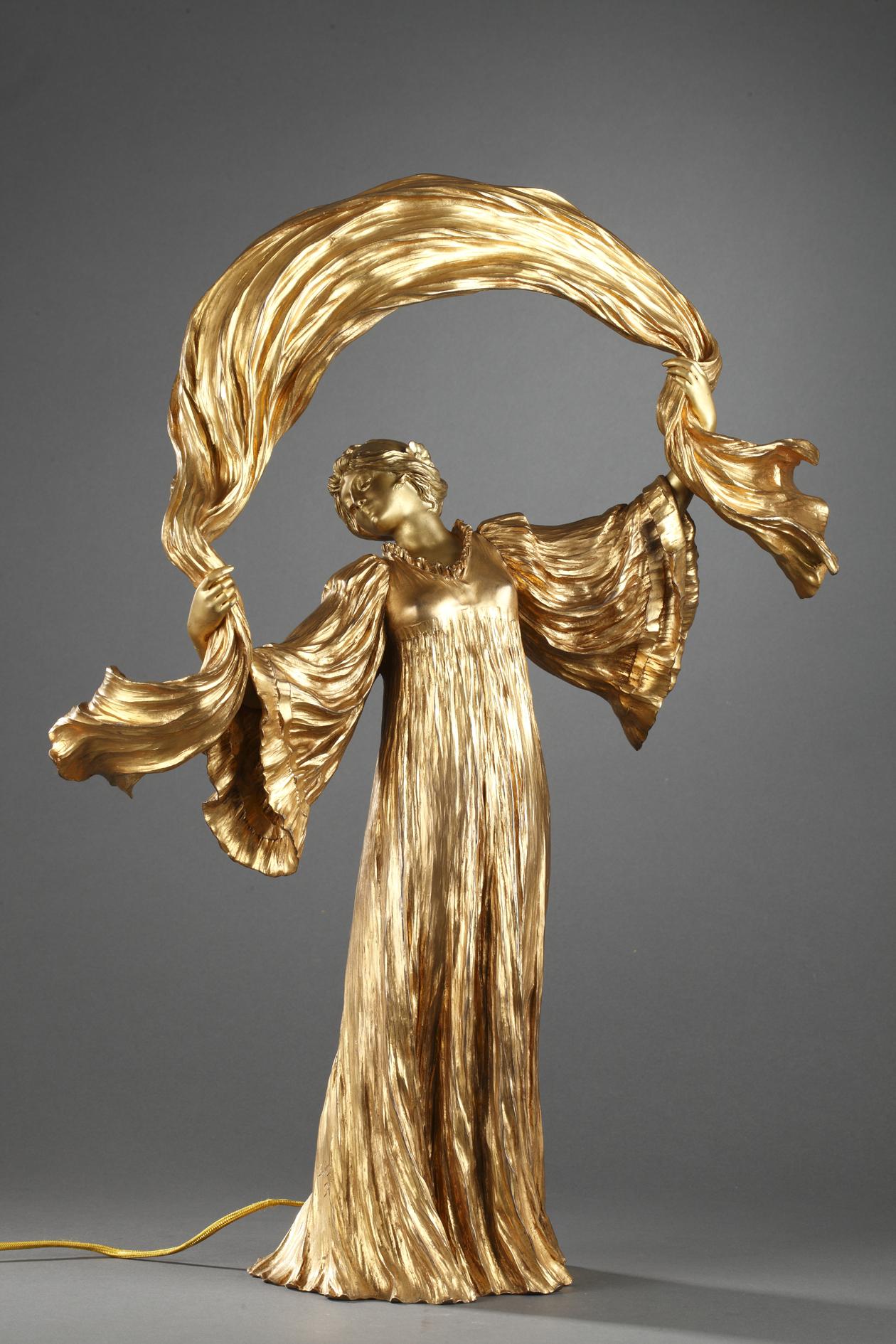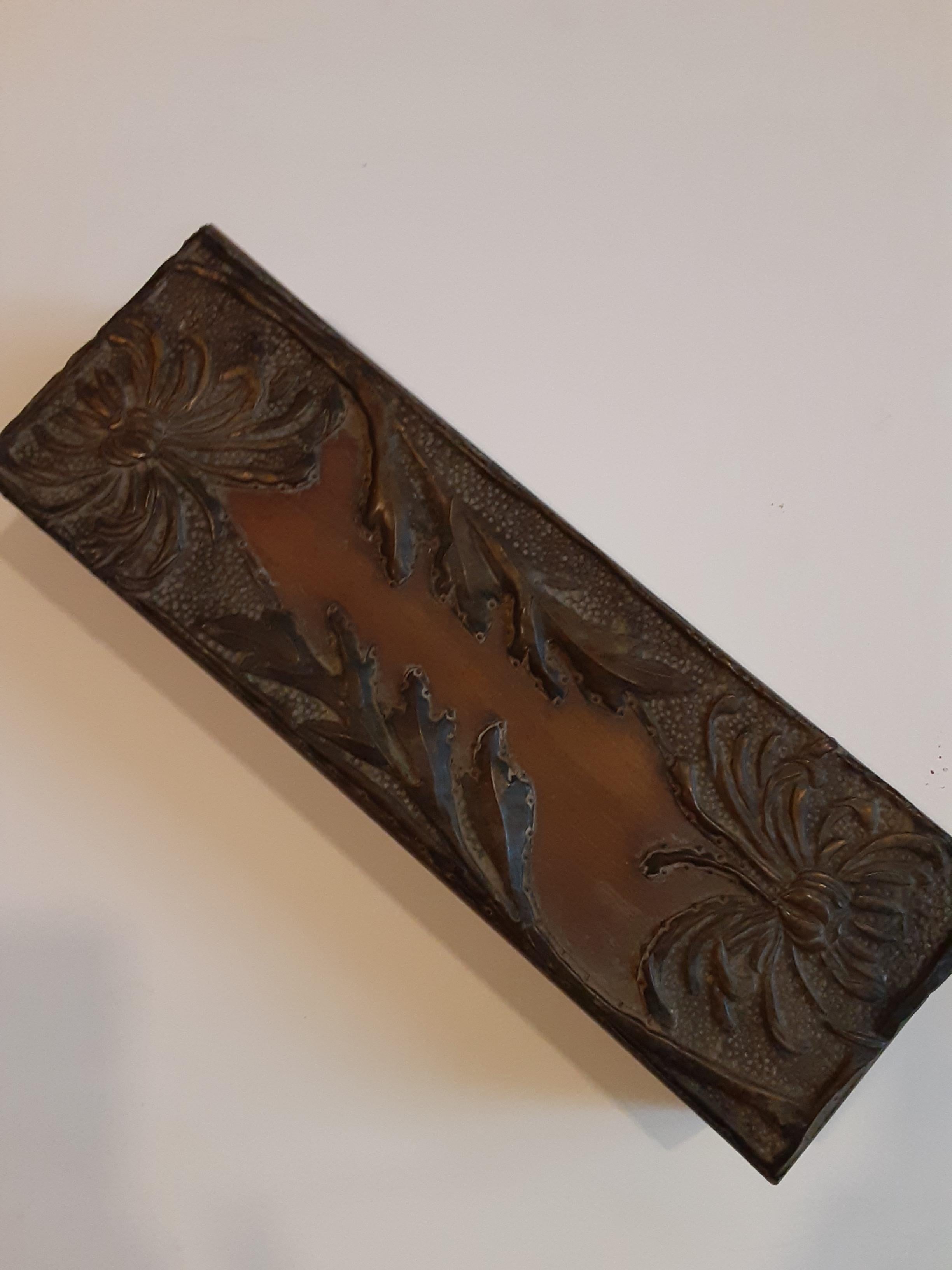Items Similar to Rare Early 20th C Bezalel Silverplate Repousse Judaica Menorah Made in Palestine
Want more images or videos?
Request additional images or videos from the seller
1 of 9
Zeev RabanRare Early 20th C Bezalel Silverplate Repousse Judaica Menorah Made in Palestine
About the Item
For standing on feet or as a wall hanging with a hole at the top for mounting on the wall. Original Bezalel School brass bronze menorah with the original silverplate intact. Including the servant light Shammash (which is more rare) and having all 8 cups. all four feet are intact (although very slightly bent from use), which is noteworthy, as when this menorah appears at auction, the feet tend to be missing as they are easily detached. Backplate is a design of the Holy Temple Menorah lighting by the high priest and a Ze'ev Raban design, similar examples are illustrated in the book "Raban Remembered Jerusalem's Bezalel School
The Bezalel Academy of Arts and Design, was founded in 1906 by Boris Schatz. In 1903, Schatz met Theodore Herzl and became an ardent Zionist. At the Zionist Congress of 1905, he proposed the idea of an art school in the Yishuv (early Jewish settlements), and in 1906 he moved to British Mandate Palestine, later Israel and founded the Bezalel School of Art in Jerusalem. Bezalel, which was a school for crafts as well as for graphic art, became successful very rapidly. Schatz’s vision was to develop useful judaic arts and crafts among Palestinian Jews, thereby decreasing the dependence on charity. At the same time, he sought to inspire his students to create a Jewish national style of the arts, in order to promote the Zionist endeavor. The inhabitants of 19th-century Palestine, both Jewish and non-Jewish, had produced mostly folk art, ritual objects and olive-wood and shell-work souvenirs, so the founding of Bezalel provided a professional and ideological framework for the arts and crafts in Jerusalem. The school employed workers and students, of whom there were 450 in 1913, in manufacturing, chiefly for export, decorative articles ranging from cane furniture, inlaid frames and ivory and wood carvings, to damascene and silver filigree and repousse work.
A major part of Schatz’s school was the workshops, which, starting with rug-making and silversmithing, eventually offered 30 different crafts. Workshops included the "Menorah" workshop where they designed relief and souvenirs made of terra-Cotta, and the Sharar, Stanetsky and Alfred Salzmann workshops where Menorah lamps, candlesticks, brass plates for Passover, and many other ceremonial and souvenir items were made.
Intended to create an original national style, Bezalel artifacts were a
mixture of oriental styles and techniques with Art Nouveau features, art deco styles and influences from the Arts and Crafts Movement.
The Academy reopened after Schatz's death in 1935 led by the new director, Joseph Budko, who took advantage of the many new European immigrants' talent and energy and succeeded in revitalizing the school. In the mid 1930's, Bezalel was reestablished by German and European refugee artists driven to Palestine by the Nazis, and underwent a final reorganization in 1965 that established Bezalel as a school for crafts. A small museum was added to the school which became the foundation for the Bezalel Museum
later to become the world famous Israel Museum. Bezalel strove to foster in its students a national style of art, drawing both from European
techniques and Near Eastern art forms. While centers of Jewish art could be found elsewhere early in the 20th century (such as the school of Yehuda Pen in Vitebsk where Marc Chagall had studied) these were even more short lived. Bezalel subjects were a combination of traditional Jewish religious images, Zionist symbols, Biblical themes, views of the Holy Land and depictions of the flora and fauna of Palestine.
Artists at the Bezalel School used holy places, female figures and the beautiful landscapes of the holy land in their work.
Zev Raban, a major Bezalel artist, also designed products for various artistic cooperatives that were under the control of Bezalel: for Moshe Murro, Bezalel amulet artist, Raban designed many items, later executed in metal and ivory. For the famous Bezalel Yemenite jeweler- Yichieh Yemini, Raban designed many jewelries and Filigree works. Renowned Bezalel School artists include Meir Gur Arieh, Zev Raban, Jacob Eisenberg, Joseph Budko Jacob Steinhardt, and Hermann Struck.
- Creator:Zeev Raban (1890 - 1970, Israeli)
- Dimensions:Height: 6.5 in (16.51 cm)Width: 8.5 in (21.59 cm)Depth: 2 in (5.08 cm)
- Medium:
- Movement & Style:
- Period:
- Condition:
- Gallery Location:Surfside, FL
- Reference Number:1stDibs: LU38214286752
About the Seller
4.9
Platinum Seller
These expertly vetted sellers are 1stDibs' most experienced sellers and are rated highest by our customers.
Established in 1995
1stDibs seller since 2014
1,566 sales on 1stDibs
Typical response time: 1 hour
- ShippingRetrieving quote...Ships From: Surfside, FL
- Return PolicyA return for this item may be initiated within 3 days of delivery.
More From This SellerView All
- Rare Judaica Chevron Bezalel Zeev Raban Chromolithograph (made in Palestine)By Zeev RabanLocated in Surfside, FLJerusalem's Bezalel School The Bezalel Academy of Arts and Design, was founded in 1906 by Boris Schatz. In 1903, Schatz met Theodore Herzl and became an ardent Zionist. At the Zionis...Category
Early 20th Century Art Nouveau More Art
MaterialsLithograph
- Bezalel School Jerusalem, Middle Eastern Arab Man in Turban Circa 1920s EtchingBy Jacob EisenbergLocated in Surfside, FLGenre: Realism Subject: Portrait Medium: Etching Surface: Paper Country: Israel Dimensions with Frame: 18" x 114" Jacob Eisenberg (1897–1965) (also Yaakov Eisenberg) was an Israeli ...Category
1920s Art Nouveau Portrait Prints
MaterialsEtching
- Vintage 1971 Jewish Film Festival Poster Berkeley EM Lilien Art Nouveau JudaicaLocated in Surfside, FLThis is printed on heavy art paper. it is a lithograph or silkscreen print done after a drawing by Ephraim Moshe Lilien. Great vintage judaic art from Berkeley California in the 1970's. Ephraim Moses Lilien (Hebrew: אפרים משה ליליין; 23 May 1874 – 18 July 1925) was an art nouveau illustrator and printmaker particularly noted for his art on Jewish themes. He is sometimes called the "first Zionist artist." Ephraim Moses Lilien (Maurycy Lilien) was born in 1874, in Drohobycz, Galicia, then in the Austro-Hungarian Empire. In 1889-1893 Lilien learned painting and graphic techniques at the Academy of Arts in Kraków. He studied under Polish painter Jan Matejko from 1890 to 1892. As a member of the Zionist Movement, Lilien traveled to Ottoman Palestine several times between 1906 and 1918. Lilien attended the Fifth Zionist Congress, held in Basel, as a member of the Democratic Fraction, an opposition group that supported the development of secular national culture. In 1905, at the Seventh Zionist Congress, in Basel, he, along with Boris Schatz, became a member of a committee formed to help establish the Bezalel Art School. As part of that work he accompanied Schatz to Jerusalem. Lilien was one of the two artists to accompany Boris Schatz to what is now Israel in 1906 for the purpose of establishing Bezalel Academy of Arts and Design, and taught the school's first class in 1906. Although his stay in the country was short-lived, he left his indelible stamp on the creation of an Eretz Israel style, placing biblical subjects in the Zionist context and oriental settings, conceived in an idealized Western design. In the first two decades of the century, Lilien's work served as a model for the Bezalel group. Lilien is known for his famous photographic portrait of Theodor Herzl. He often used Herzl as a model, considering his features a perfect representation of the "New Jew." In 1896, he received an award for photography from the avant garde magazine Jugend. Lilien illustrated several books. In 1923, an exhibition of his work opened in New York. Lilien's illustrated books include Juda (1900), Biblically-themes poetry by Lilien's Christian friend, Börries Freiherr von Münchhausen, and Lieder des Ghetto (Songs of the Ghetto) (1903), Yiddish poems by Morris Rosenfeld...Category
1970s Art Nouveau Prints and Multiples
MaterialsLithograph
- Rare Antique Enamel Singer Sewing Machine Sign - HebrewLocated in Surfside, FLRare antique enamel Vintage Singer Sewing Machine advertisement Sign in Hebrew or Yiddish. Please see photos for condition. Rare early Je...Category
20th Century More Art
MaterialsEnamel
- Judaica Copper Plaque Israeli Artist Mordechai Avniel, Palestine, Bezalel SchoolBy Mordechai AvnielLocated in Surfside, FLMORDECHAI AVNIEL Minsk, Belarus, b. 1900, d. 1989 Mordechai Avniel is best known for his deft and singular landscape work. He said of his scenes of Israel: "I loved the Israeli landscape. While roaming the country extensively, I gradually absorbed its atmosphere, its lights and moods, the view of mountains and valleys, the Sea of Galilee...Category
20th Century Modern More Art
MaterialsCopper
- Rare Brutalist Mexican Sculpture Pendant Surrealist Stone Necklace Pal KepenyesBy Pal KepenyesLocated in Surfside, FLChain is 23.5 inches long. Pendant is 3.75 X 2 X 1 inches This piece is not signed. but the chain matches completely with the signed one that I have. Pal Kepenyes is a sculptor and researcher of Hungarian art, whose artistic production includes sculptures of small and medium format, jewelry and miniature decorative pieces, all made by hand, without any machinery. Wearable art. Sculptural pendant on matching chain cast in polished bronze or brass. Reminiscent of Harry Bertoia. Organic Modernism. Mod, space age, handmade artisan, studio jewelry. Pal Kepenyes, wearable art pioneer. sculptor, goldsmith, jeweler, artist, was born in 1926 in Hungary. His creative talent, specifically in creating sculpted works, was evident early on. He moved to Budapest, where he first studied at the University of Arts and Crafts and later at the Academy of Fine Arts. His professor, Beni Ferenczy was one of Hungary's most influential sculptors. Pal Kepenyes (20/21st century) is active/lives in Hungary, Mexico. Pal Kepenyes is known for sculpture, jewelry making, miniature decorative pieces especially influenced by Mexican folk art and folklore. His work also includes animals, lions, tigers, fish, nude figures and milagros. He began his studies at the School of Decorative Arts in Budapest, and then was a prisoner of war during the Stalinist regime. In 1956, at the end of the Hungarian Revolution, he finally was released and left the country for Paris, where he studied at the School of Fine Arts. In 1956, he also traveled to Mexico, a country to which he has been devoted for the rest of his life because of his attraction pre-hispanic cultures. Along with Pedro Friedeberg, Arnold Coen, Vladimir Cora, Byron Galvez, Mathias Goeritz, Leonardo Nierman, Gabriel Orozco...Category
1960s Abstract Sculptures
MaterialsStone, Bronze
You May Also Like
- French Crystal Bronze Chandelier ca. 1910Located in Long Island City, NYThis gorgeous chandelier is from circa 1910 with 24 candle bulbs an a multitude of gemini cut crystal. Believed to be French in origin, and will be stunning in any space. Has been re...Category
1910s Art Nouveau More Art
MaterialsBronze
- Cufflinks Red Gold Flower Vintage Black Porcelain Jewelry Men (MADE TO ORDER)By Melanie ShermanLocated in Kansas City, MOMelanie Sherman Cufflinks with Red & Gold Flowers on Black Porcelain Dimensions: 20mm x 17mm x 17mm Materials: Porcelain, Glaze, Vintage Decal Metal type: Brass COA Provided * These pieces are made to order any may exceed the 10 Day Shipping time frame Melanie Sherman is a ceramic artist, born in Germany and currently residing and working in Kansas City, Missouri. She has a Bachelor of Fine Arts Degree in ceramics from the Kansas City Art Institute. Her background is in graphic design, where she developed an eye for pattern and decoration. In her ceramics she combines her love for ornamentation and her fascination with the history of ceramics, referencing 18th century European porcelain...Category
2010s Art Nouveau More Art
MaterialsGold, Brass
- Cufflinks Red Gold Flower Vintage Black Porcelain Jewelry Men (MADE TO ORDER)By Melanie ShermanLocated in Kansas City, MOMelanie Sherman Cufflinks with Red & Gold Flowers on Black Porcelain Dimensions: 20mm x 17mm x 17mm Materials: Porcelain, Glaze, Vintage Decal Metal type: Brass COA Provided Melanie Sherman is a ceramic artist, born in Germany and currently residing and working in Kansas City, Missouri. She has a Bachelor of Fine Arts Degree in ceramics from the Kansas City Art Institute. Her background is in graphic design, where she developed an eye for pattern and decoration. In her ceramics she combines her love for ornamentation and her fascination with the history of ceramics, referencing 18th century European porcelain...Category
2010s Art Nouveau More Art
MaterialsGold, Brass
- Antique handmade lamp with botanical motifs by Muller FrèresLocated in New York, NYAntique handmade lamp with botanical motifs by Muller Frères. Muller Frères were renowned glassmakers from Lunéville, France, famous for producing art n...Category
Early 20th Century Art Nouveau More Art
MaterialsIron
- "Dancer with the scarf" lampBy Agathon LéonardLocated in PARIS, FRAgathon LÉONARD (1841–1923) Lamp "Danseuse à L'Écharpe" "Dancer with the scarf" lamp A very rare sculpture forming a table lamp, made in gilded bronze The scarf hides the light bulb Signed on the side of the dress "A. Léonard Sclp" Cast by Susse Frères (with founder stamp) France circa 1905 height 60 cm A similar model is reproduced in "Les bronzes du XIXe siècle", P. Kjellberg, Les éditions de l'amateur, 2005, page 460. Biography: Léonard Agathon Van Weydeveldt, said Agathon Léonard (1841-1923) was a sculptor of Belgian origin naturalized French. After studying art at the Lille Academy of Fine Arts and then at the École des Beaux-Arts in Paris, Agathon Léonard settled in Paris for a long time, where after having exhibited at the Salon of 1868, he joined the Society of French artists in 1887, then to the National Society of Fine Arts in 1897. Very involved in the artistic movement of the Art Nouveau style, he exhibited many pieces (medallions, bronze statuettes and ceramics) finely worked. Following an order from the Manufacture Nationale de Sèvres, dating from 1898, Agathon Léonard exhibited at the Universal Exhibition of 1900 in Paris his famous table centerpiece "Game of the scarf" in porcelain biscuit, composed of fifteen statuettes representing dancers with pleated dresses reminiscent of Loïe Fuller's choreographies or Neo-Greek dancers...Category
Early 1900s Art Nouveau More Art
MaterialsBronze
- Art Nouveau European BoxLocated in Troy, NYThis elegant Art Nouveau box was originally made in France circa. 1910, and remains in very good condition. It was acquired from a French estate. The lid of the box is decorated with...Category
1910s Art Nouveau Still-life Sculptures
MaterialsMetal, Bronze





